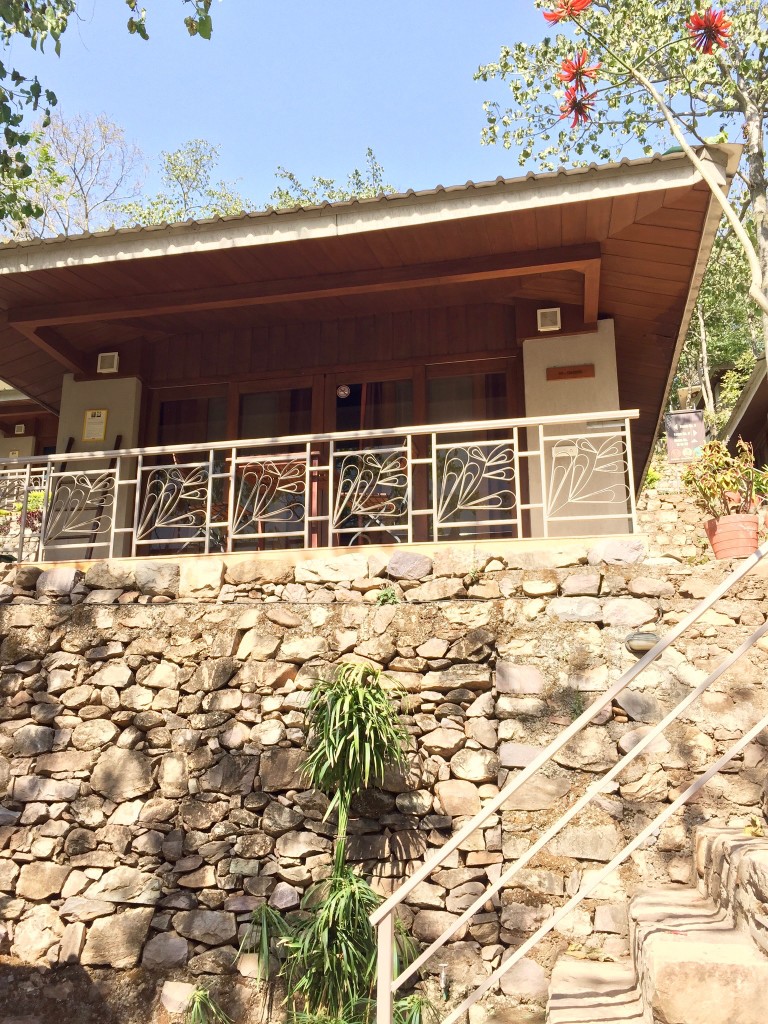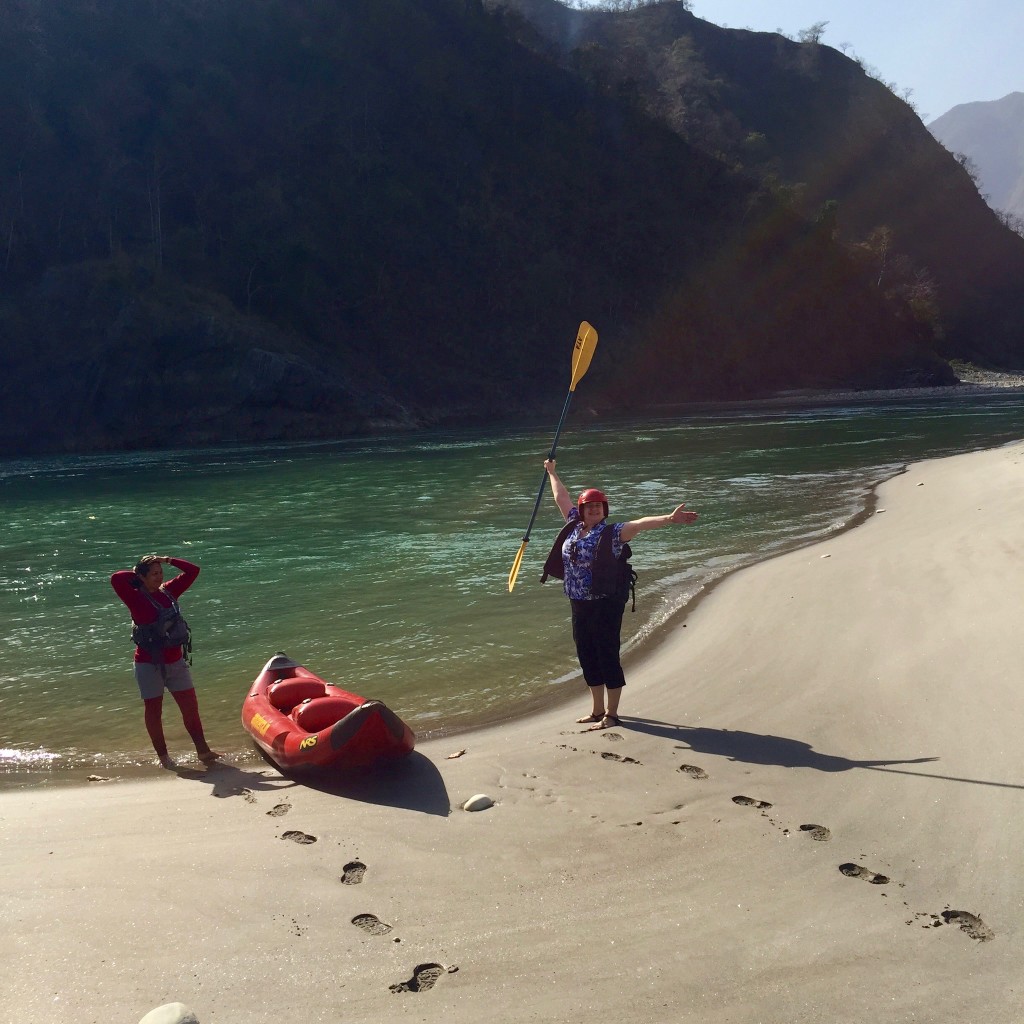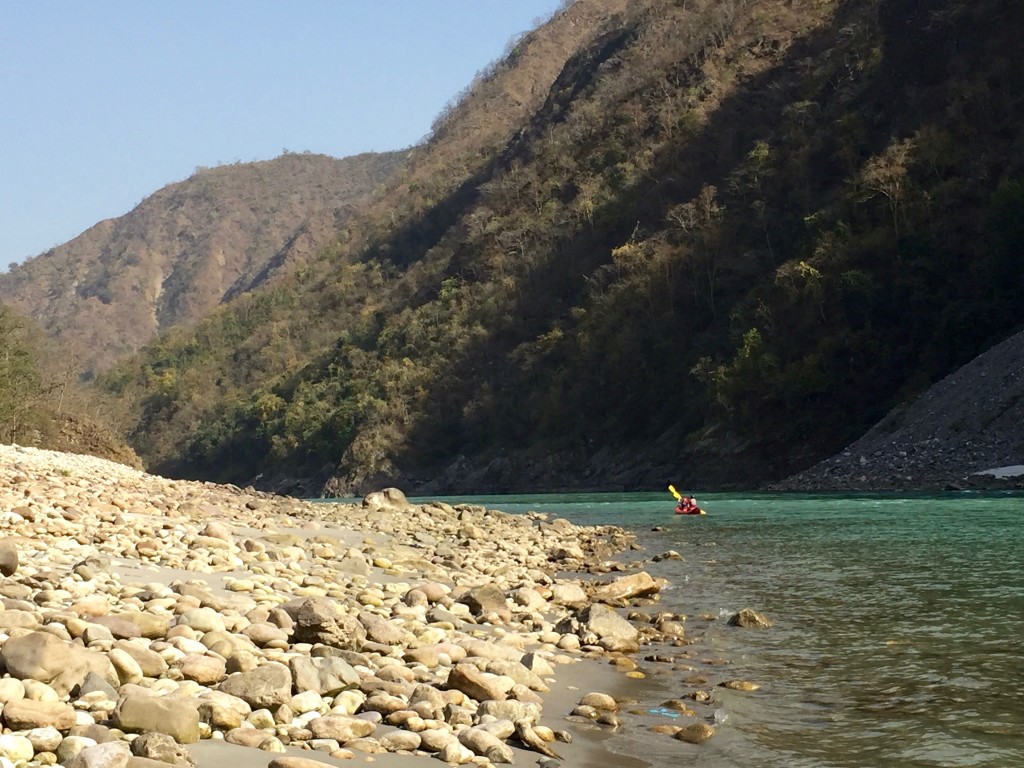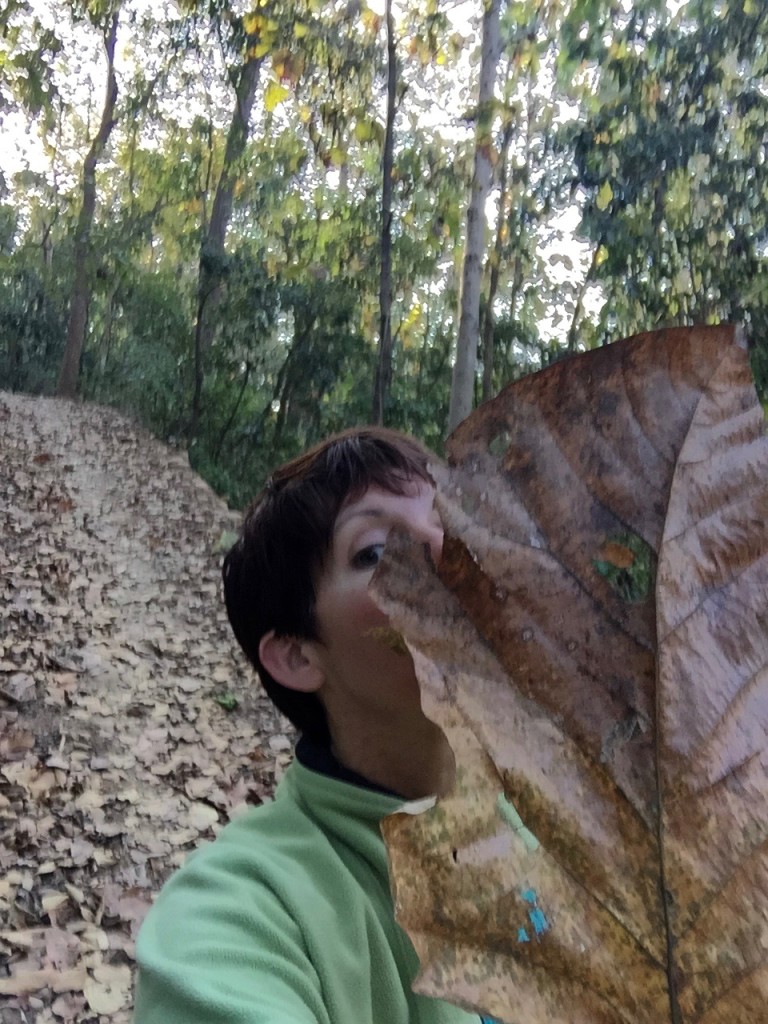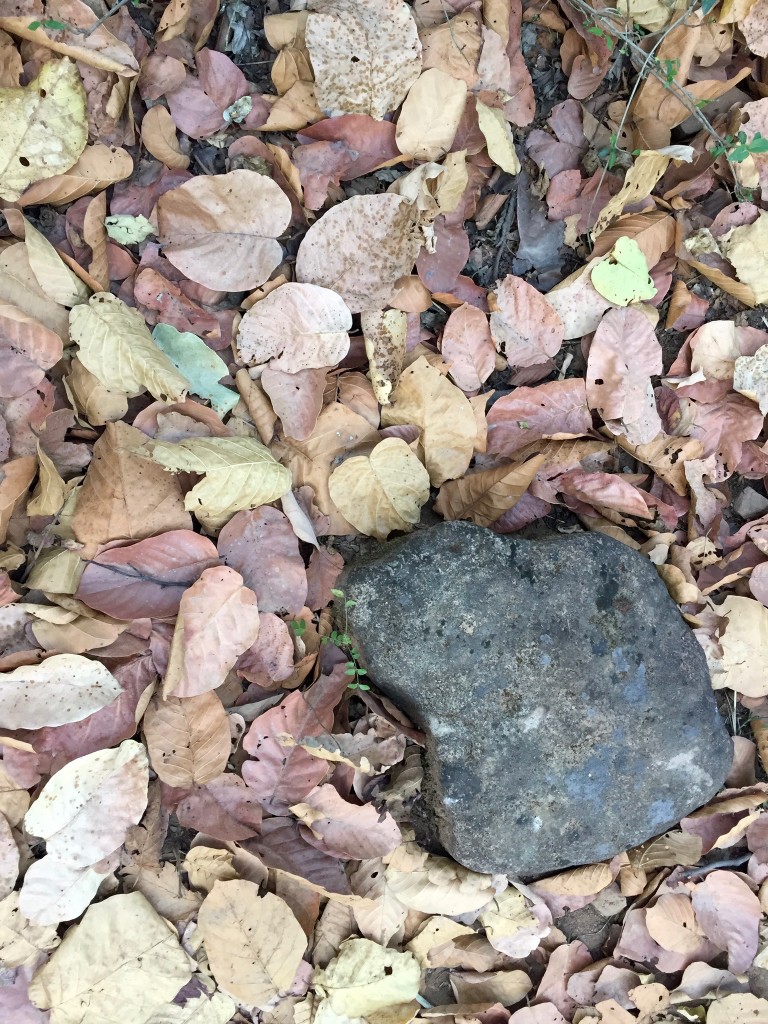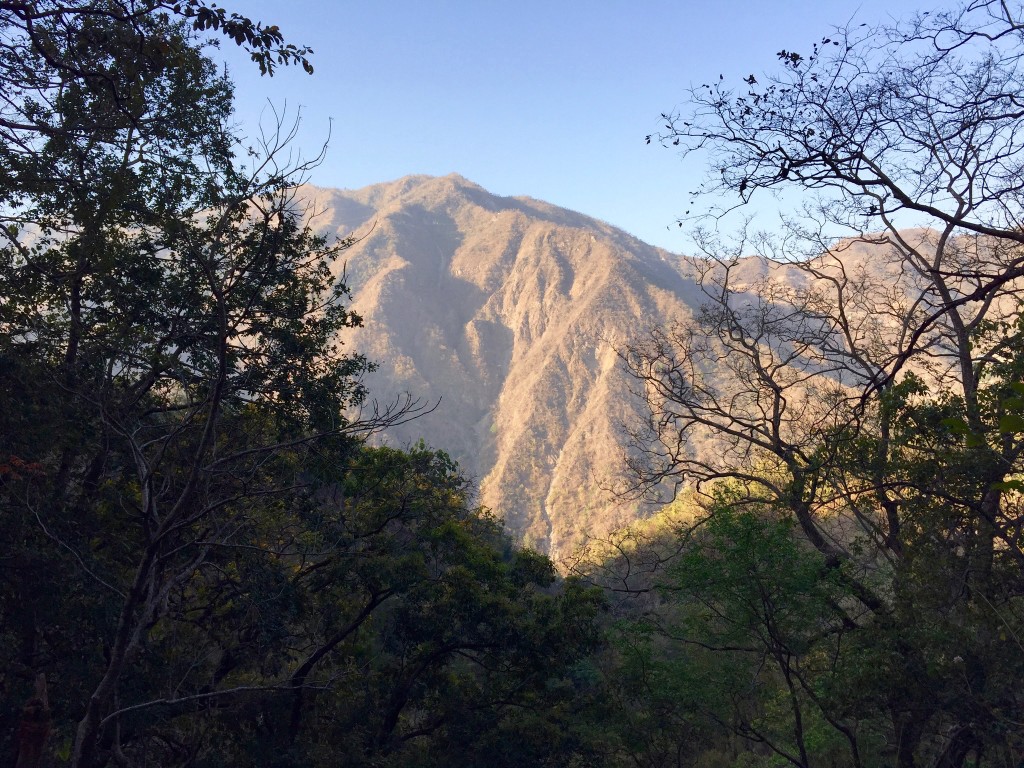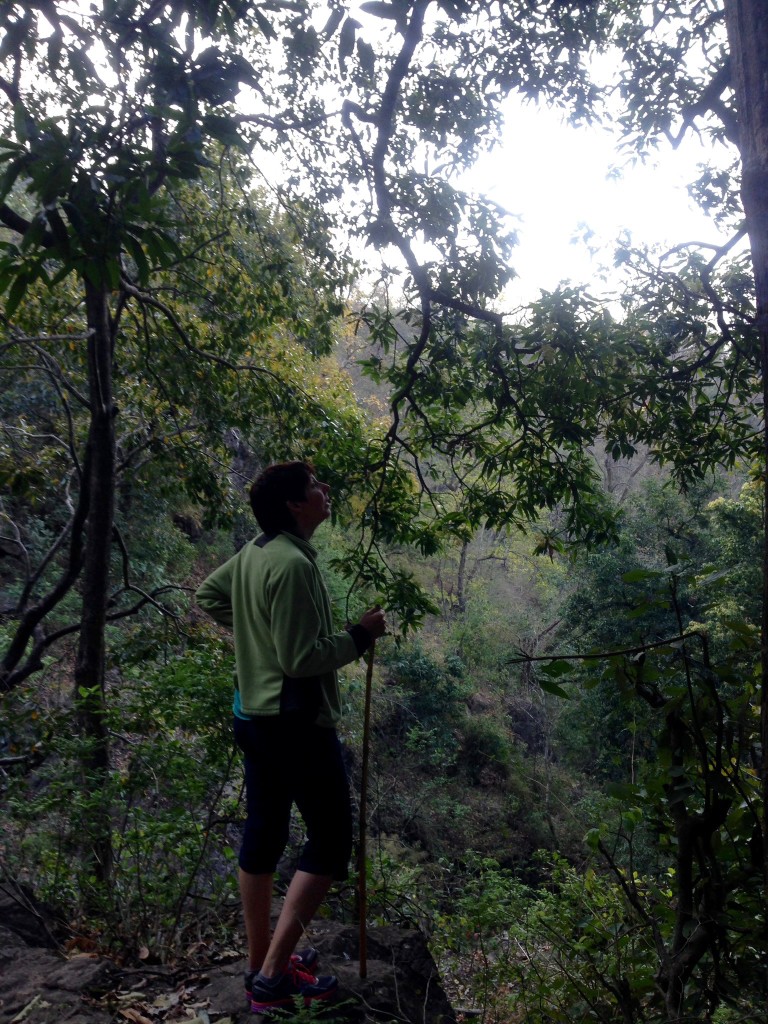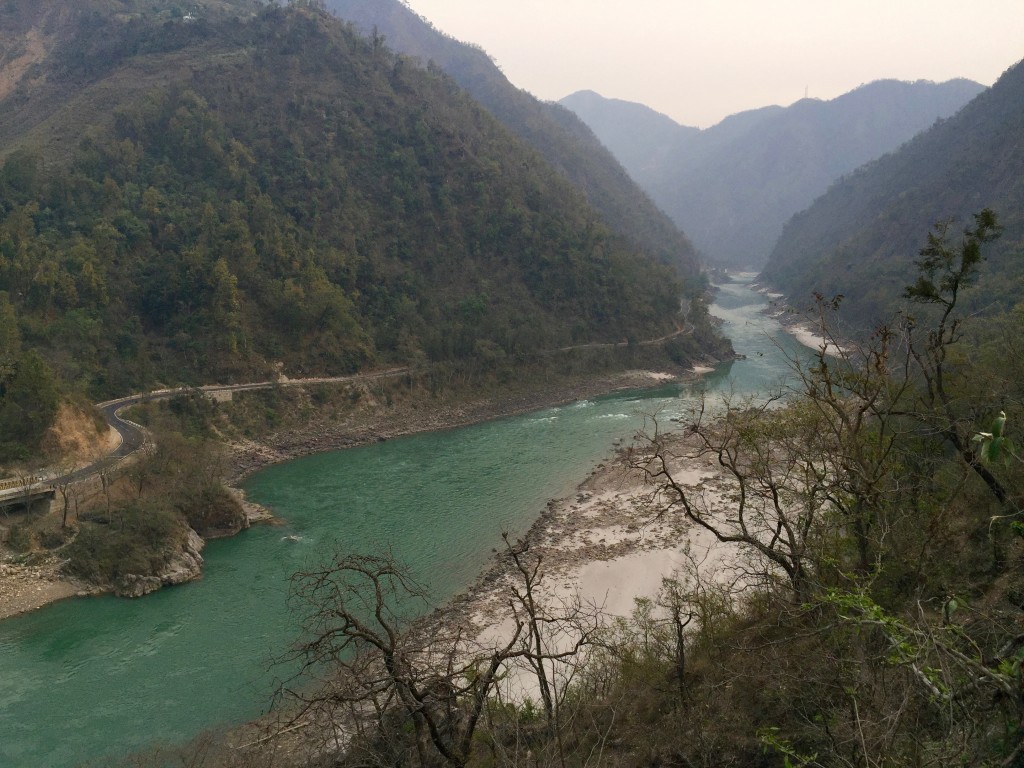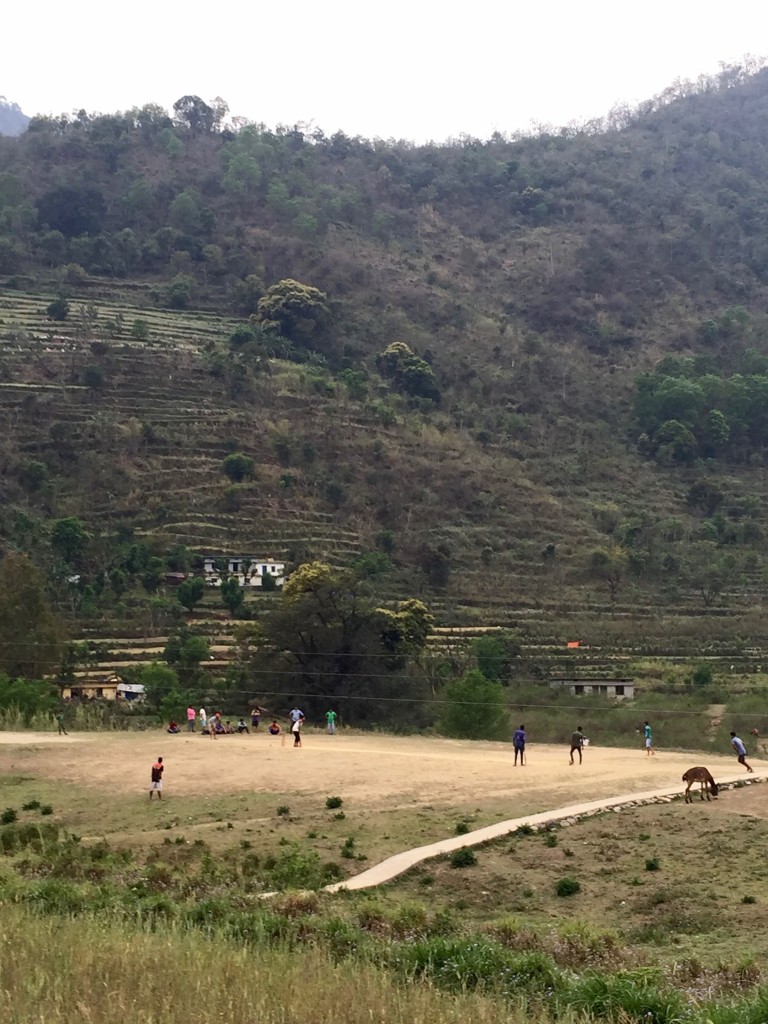I barely had time to unpack my suitcase, do laundry and repack, and I was off again.
Spring Break!
Before I knew I would chaperone the high school mini-course, I was craving a traffic-free get-away to nature. I got that, unexpectedly, with our trip to Krishna Ranch last week, but I had already booked a trip with my friend Alli for the following week. We took the train to Rishikesh and stayed at Atali Ganga, a peaceful little eco-resort on the shores of the Ganges River (Ganga in Hindi).
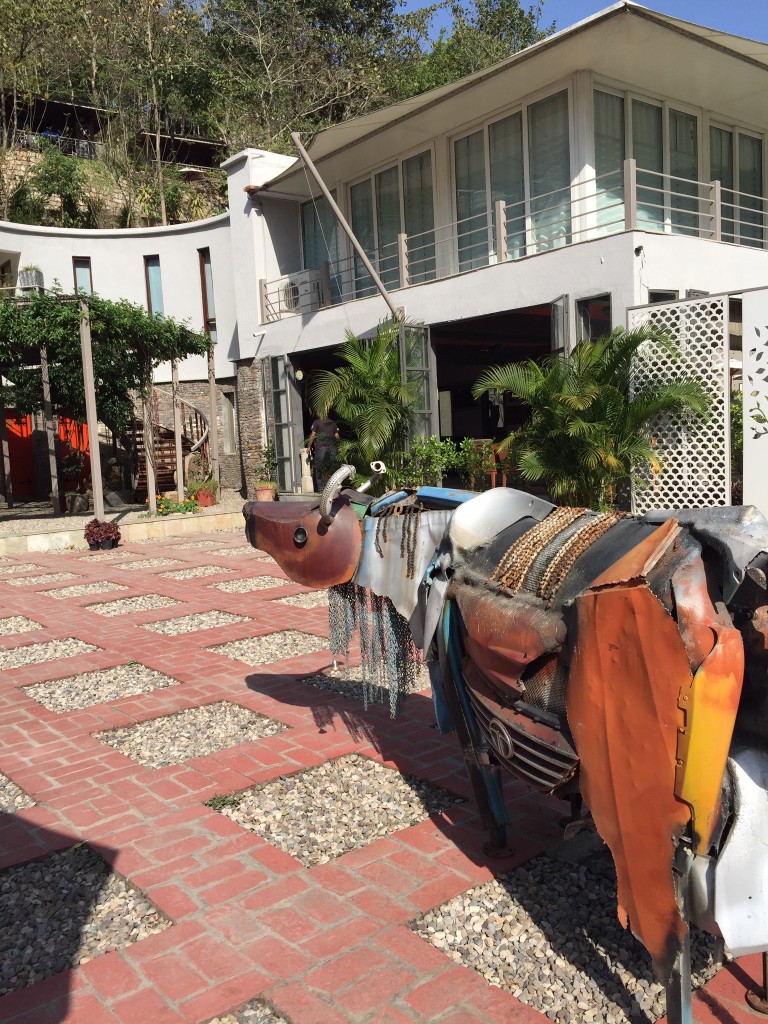
Atali Ganga stretches up the hillside on the east side of the river. From the main road, a short steep driveway takes you to the reception area, which includes a pool and climbing wall. Stone steps and pathways lead to the Green Deck, a grassy lounging area on the second level; Café White Water, where we ate all our meals, on the third level; and then to individual cottages on five subsequent levels. Alli and I were neighbors on the fifth level, 85 knee-jarring stairs from the lobby.
View from the restaurant deck.
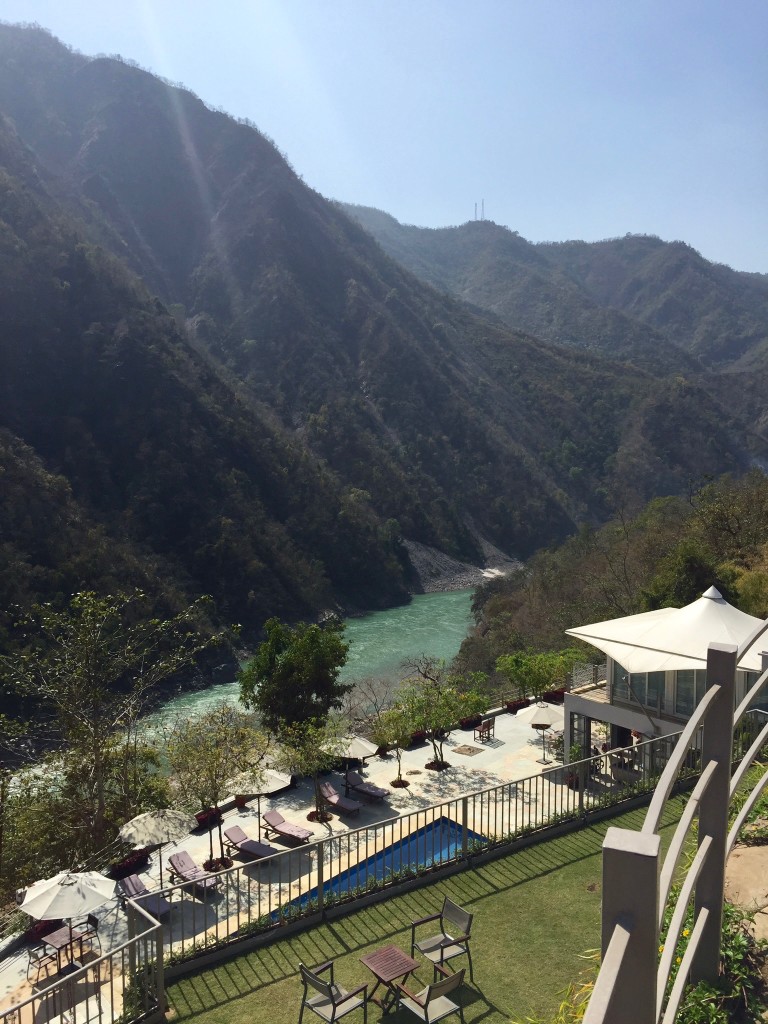
Trees, shrubs and potted plants lined the paths and surrounded the buildings. Small tables and chairs, shade umbrellas and loungers were tucked here and there, providing ample spots for reading, napping, writing, or chatting. My cottage far exceeded expectations with its stone tile floor, comfortable bed, hot shower, and screened windows to let in the fresh breeze. I didn’t even notice all the special touches until I needed them, like when I realized the bamboo ladder just outside my front door was meant for drying my wet clothes, or when I spotted the yoga mats provided in the room just as my weary muscles needed a stretch.
I also appreciated the eco-friendly efforts: Signs offered gentle reminders to preserve water and power; linens were laundered only every three days; soap and shampoo came from wall-mounted dispensers instead of disposable containers; and housekeepers refilled glass bottles with fresh water each day.
On our first afternoon, we joined Sonita, one of the activity directors, for an introduction to the Ganges in an inflatable kayak. Alli and I took turns as Sonita piloted us upriver a bit and then floated back down. We both hopped out of the boat and into the icy water at the end. It was exhilarating! Afterwards, we plopped down in the riverbank’s powdery sand to enjoy the view and a cup of chai.
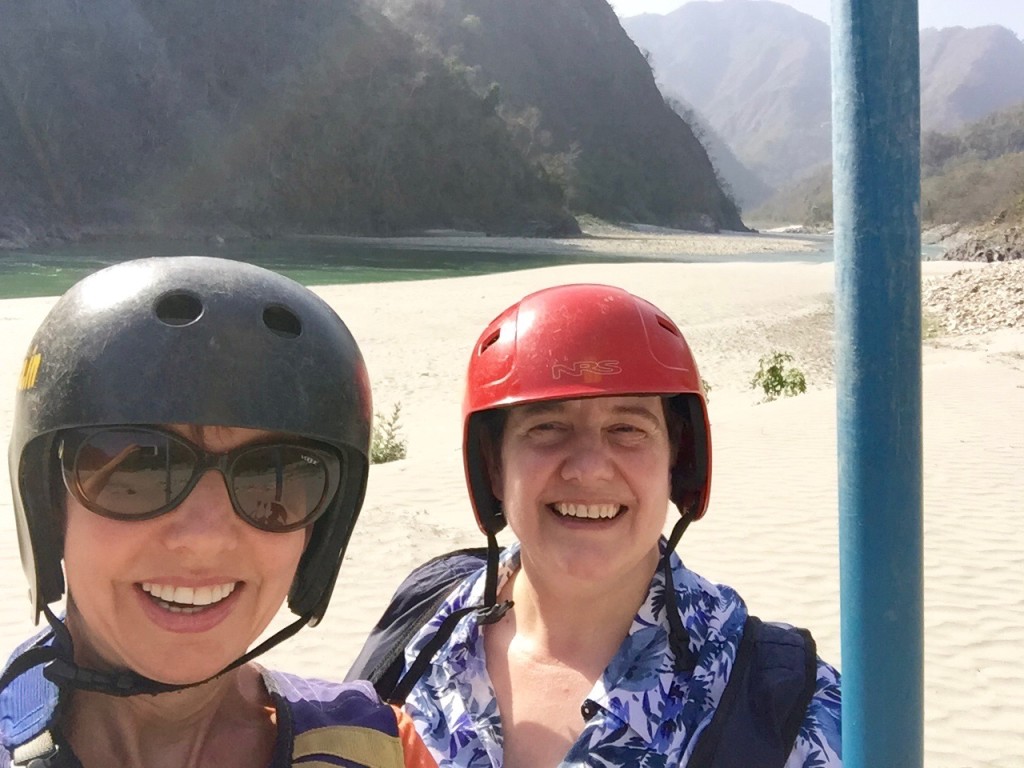
That evening, the hotel served snacks by a fire pit and set up a telescope for us to look at the moon and Jupiter before dinner.
The next morning, we joined a group for whitewater rafting. This was my virgin voyage, and I have to say the “safety talk” kind of freaked me out. I was feeling pretty nervous by the time we set off on our 24-kilometer ride. Our boat mates included a nice Indian family with two sweet children.
“Well, it can’t be too dangerous if they’re letting the kids do it,” I said, thus jinxing our journey.
After 4 kilometers, we rowed to the shore. “What are we doing?” I asked.
“Dropping off the kids,” answered our guide. “We’ll pick them up again after the big rapids.”
Oh crap.
We rowed and floated down the jade-colored river, which was calm enough at times for us to pause and check out the tree-covered hillsides, mysterious little caves, sandy beaches and paths winding through the forest. But the calm was quickly broken by 14 Class-2 and Class-3 rapids that doused us and got our hearts pounding. The rapids had funny names, such as Three Blind Mice, Golf Course, Rollercoaster, Black Money, and Return to Sender.
During one stretch, our guide encouraged us to ride along on the outside of the boat. Alli and I both hopped in the chilly water, held on to the raft’s safety line, and let the current tow us along till our limbs went numb.
Shortly before the end of our trip, we met the two children, who had been trucked downstream, and brought them back on board.
Big sigh of relief.
So I survived my first whitewater rafting experience, and it was fantastic!
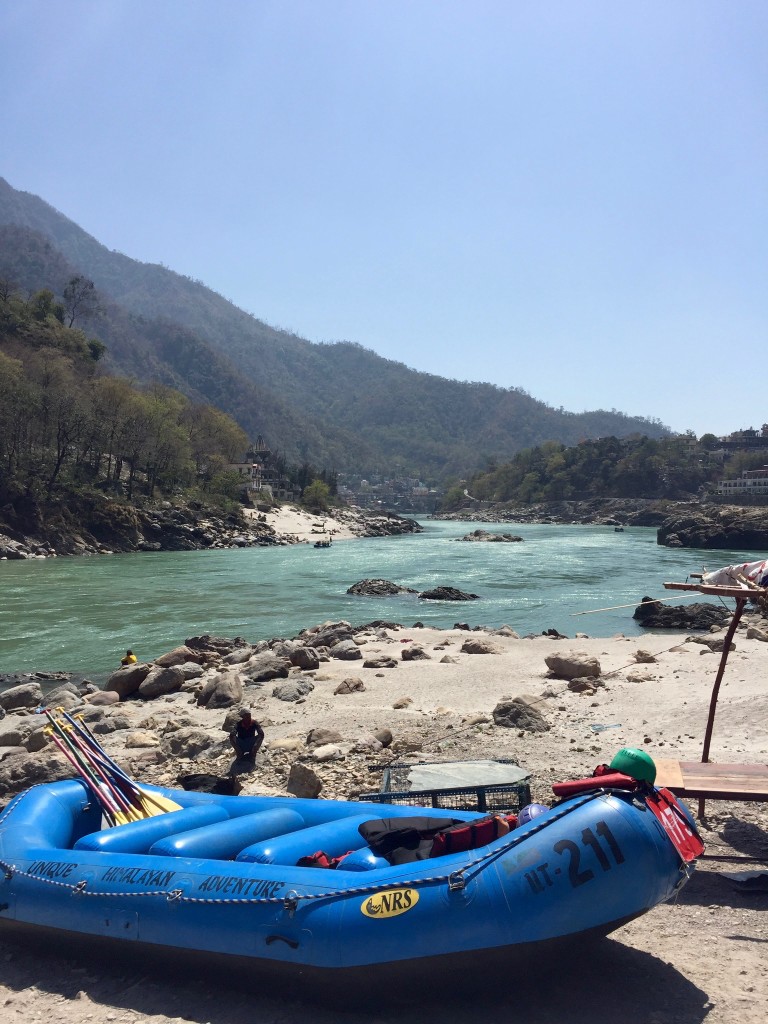
Because this stretch of the holy Ganges River looks nothing like the brown, toxic sludge that creeps into the holy city of Varanasi, I falsely assumed that riverside cremations were prohibited up here. However, we actually saw two on this day. One had just finished, and the family members were brushing ashes in to river. The other was just getting started with a pile of wood and a body on a pallet nearby. That was a little disconcerting.
Back at the fire pit that evening, under a full moon, we chatted with Manoj Biswas, the owner of Atali Ganga. He explained that this section of the river was the most holy for North Indians, and riverside cremations were not only allowed, they were sacred. If you can’t cremate your loved ones in nearby Haridwar, then you at least find a way to bring their ashes here to put in the river, Manoj said.
He also helped us understand which mountains surrounded us. There are three Himalayas, all with profound Sanskrit names, he said: The upper Himalayas (Himadri, which means “respect the snow”), the middle Himalayas (Himachal, which means “shrouded in snow”), and the lower Himalayas (Shivaliks, which means “locks of Shiva’s hair”). Atali Ganga sits in the shadow of the Shivaliks. He also said the pronunciation is Him-AL-ya, which translates to “abode of snow.” When we say Him-uh-LAY-uh, it has a different and unrelated meaning.
Why are the lower Himalayas called “locks of Shiva’s hair”? According to Hindu legend, the gods wanted to send the goddess Ganga down to earth to provide water for people. However, they feared her impact when she fell from the heavens would cause total destruction, so Shiva offered to catch her in his hair and then squeeze the water out onto the earth. Sure enough, pure water pours down the Shivaliks to join the mighty Ganga River rushing through the valley.
A sunrise hike got our next day off to a peaceful start. Alli and I climbed to the top of the Atali Ganga property to meet Robbie, one of the resort’s activity guides, who led us on a 2.5-kilometer walk on a boulder-strewn path. We saw barking deer (and one barking dog), peacocks, wild chickens, trees full of langur monkeys, a little flock of red-cheeked parakeets, and a few other birds, although most stayed hidden in the foliage. Robbie noted that winter, with its naked trees, is the best time for birding. Still, we could hear their chatter. Here’s a recording of peacocks.
We crunched along a carpet of dry leaves, past several termite towers, through a narrow gully that fills with water during monsoon season, near a small village (with only four houses and a field of wheat) and down to the road, where a van hauled us back to the hotel.
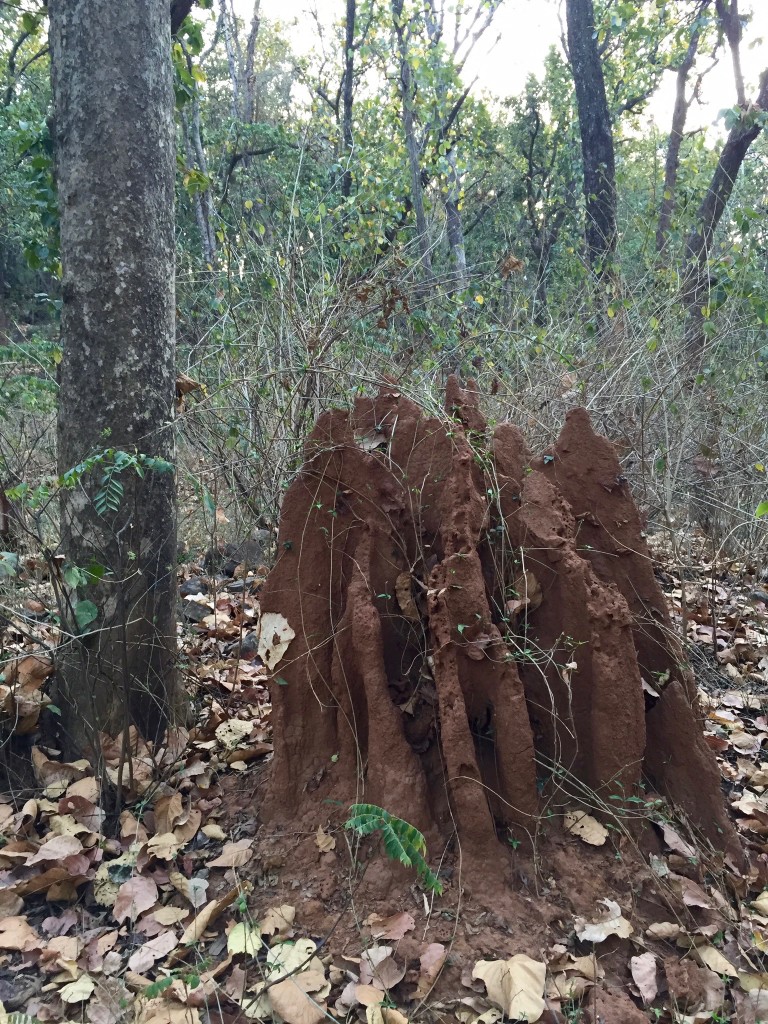
Robbie showed us these hard little seeds that were used as a unit of measurement for weight before the British showed up with their drachms, ounces, pounds and stones.
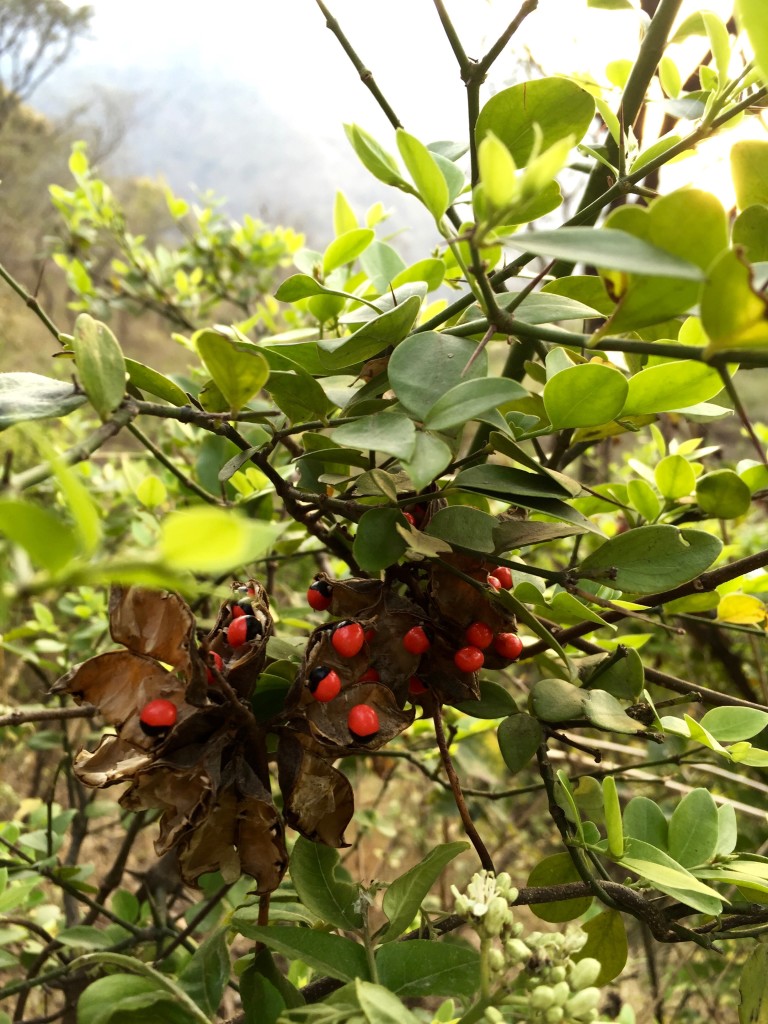
We had planned to play on the resort’s high ropes course, but we opted instead for a lazy day of lingering over coffee and reading in the shade. After a quick dip in the pool and more lounging around, we decided to pop down to the river. We waded in the water and sat in the sand, watching other guests kayak and swim.
Day four started as a repeat of day three and turned into a whole lot of trekking for me. I joined Robbie for another early morning hike, climbing up and down the rocky paths. We didn’t spot any animals, but we heard lots of rustling in the bushes. Wild chickens, Robbie said. I asked whether people eat them. “They are very fast walking,” he said. “If people can catch, they eat.”
After crossing a nala, a dry gully that fills with monsoon rains, we fell in line behind a village woman. She trekked up the precarious hill in worn flip-flops, holding her long purple skirt with one hand and balancing a large brass pot of water on her head with the other. She said “namaskar” to me and chatted in Hindi with Robbie as she climbed. Later, Robbie told me the woman was surprised to see us hiking so early in the day. She and other women out collecting wood yesterday had seen a bear at that nala, so she warned us to be careful.
Robbie led me through a small farming village. Cows and water buffalo looked up from their breakfast to check us out.
After a bit of reading and lounging, Alli and I headed to the river for a while. It was blazing hot with no shade, so we didn’t last long. I decided to join a group going on a 4-kilometer afternoon hike.
Led by Sonita, we crossed the river on the Malakunti suspension bridge and trekked along the mountainside. (Mala means necklace, and kunti means pendant. The village of Mala sits up the hill, so the bridge is like its pendant hanging below.)
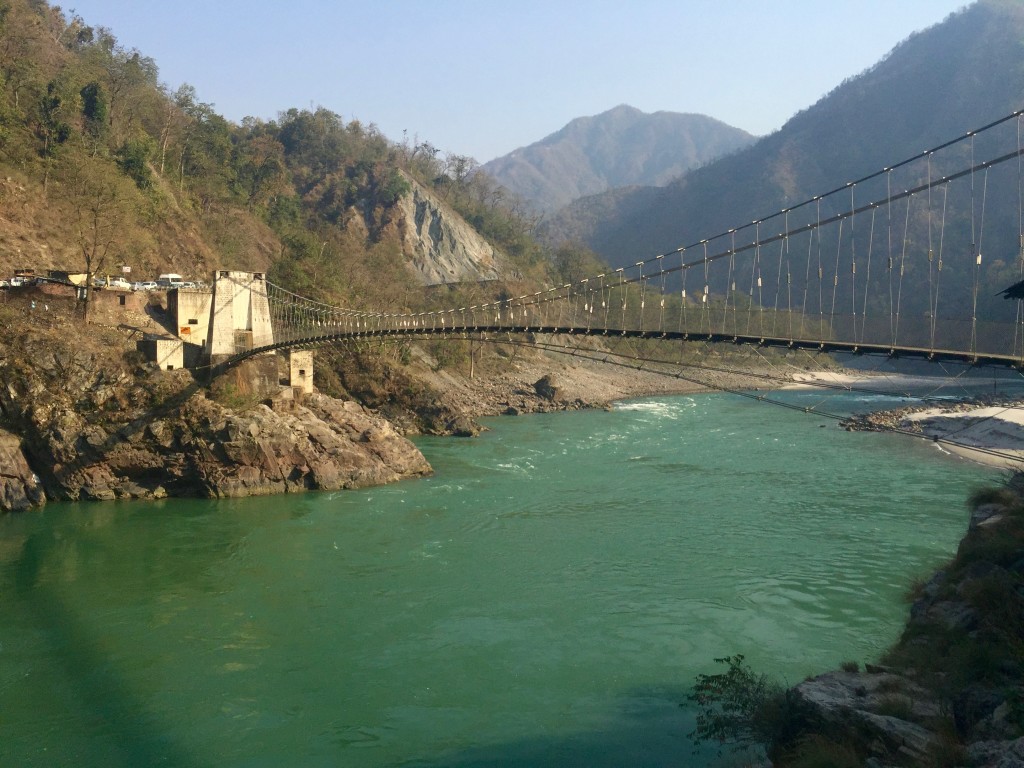
Along the way, we spotted pink and green stains on the dirt path, signs of local celebrations. It was Holi, a holiday that welcomes the arrival spring, when revelers toss colored powder or water on each other. The path rose and fell, sometimes ominously narrow with a sheer drop to the rocky beach. We often scrambled over piles of pale flat rocks, and looking up, we could see where they had broken free from the hillside.
I kept taking my phone out to snap a photo and then slipping it back into my pocket. I didn’t realize every time I did that, I butt dialed someone in the States. So sorry about that!
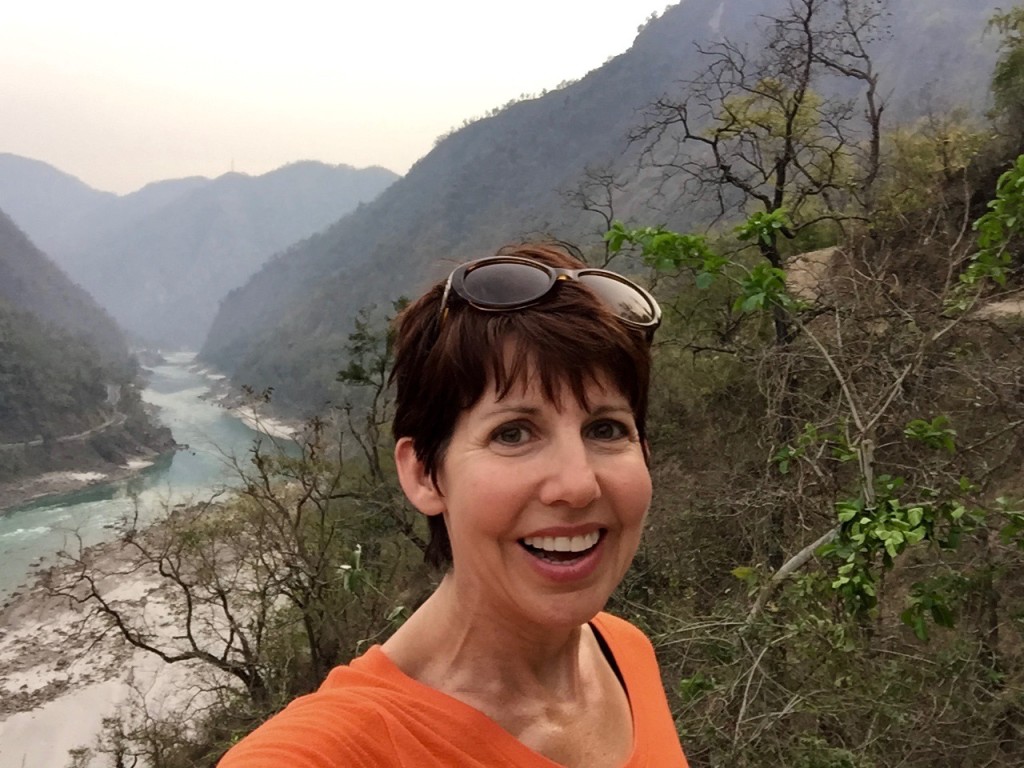
Eventually, we reached Sonita’s village, Sirasu. There, we saw ladies working in the fields, and Sonita showed us the different crops: wheat, chickpeas, onions and garlic. She also pointed to the big group of men and boys playing cricket in the distance. Women generally run the farm, care for the livestock and manage the home, while men have jobs outside the village, she said. We stopped at her mother’s house for chai. Children from the village hid behind a wall to spy on us, and a calf tied to a metal ring snorted at us and nibbled at the grass. An old woman walked by, doubled over by the load of hay on her back. I put my hands together and said, “namaste,” and she stood up, gently set down her load, and returned my greeting with a wide grin.
Sonita leading us through the wheat fields.
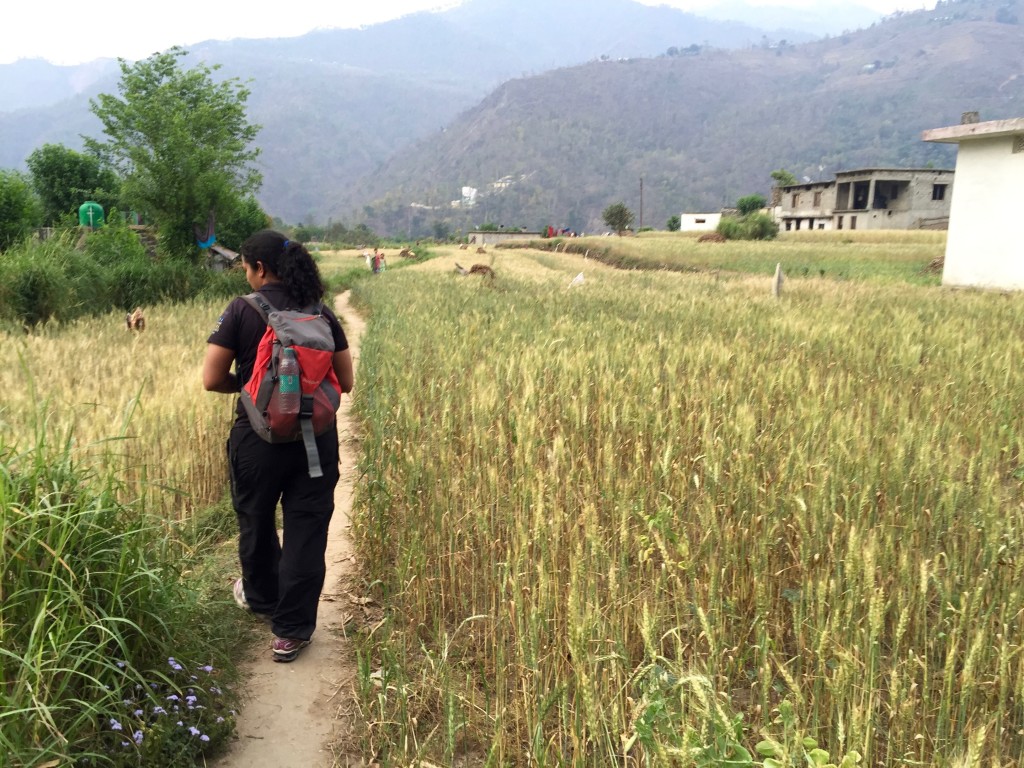
Animals next to her mother’s house.
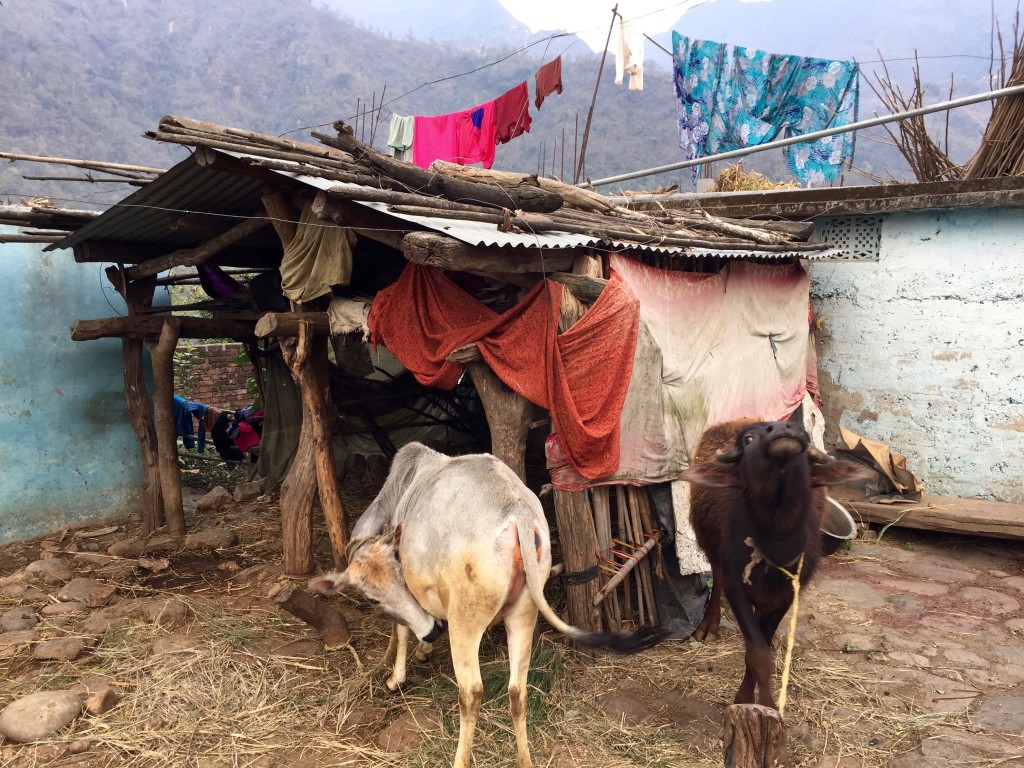
After finishing our tea, we set off again. Just past the village, bamboo scaffolding encased a huge ashram and temple under construction. Rishikesh is a magnet for spiritual pilgrims and yoga enthusiasts. This National Geographic Traveler story takes place at an ashram next to Sonita’s village and does a nice job describing the vibe of the area.
It was getting dark by the time we saw the second bridge. A precipitous path cobbled together with pale purple stones zig-zagged down the mountain. I asked Sonita if the color was natural, and she pointed across the river to where purple-tinted rock rose out of the water and blended into the hills. We walked across the bridge and up another steep hill to the road, where our bus waited to drive us back to Atali Ganga.
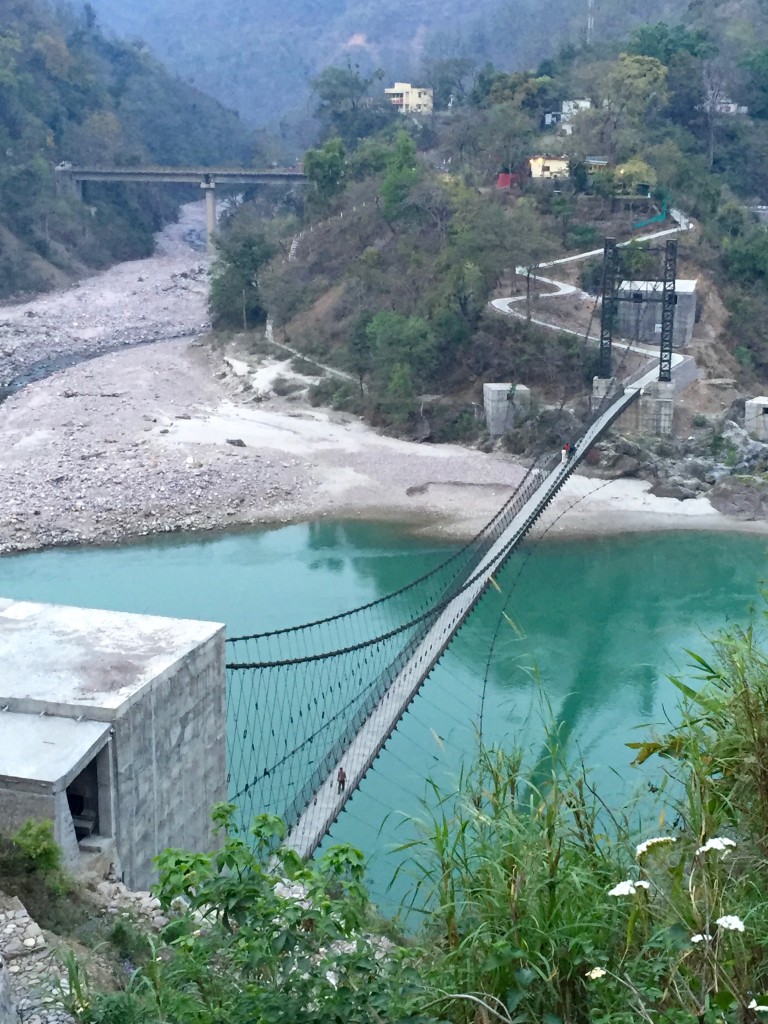
Our final day in Rishikesh, we had to check out early, so we spent most of the day in the open-air reception area, reading and writing. I felt my usual melancholy settle in, knowing I had to leave behind beauty and fresh air and face the reality of Delhi’s smog and traffic. What a perfect week, though. And, seriously, what an amazing month – so many Incredible India experiences!
That’s it for a while, though. My next big journey will be a life-changer as Tony and I wave farewell to India in just two months, travel to Michigan for a quick visit, and then move to new jobs and a new home in Santiago, Chile.

